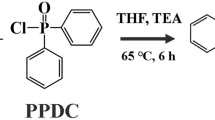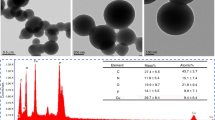Abstract
In order to develop a highly efficient flame-retardant system, a phosphonate-based ionic liquid named 1-vinyl-3-(diethoxyphosphoryl)-propylimidazolium bromide (IL) was synthesized and introduced into epoxy resin (EP). With only 4 wt% loading, EP/IL composite passed UL-94 V-0 rating, and its limiting oxygen index value increased to 34.9% from 25.9% for neat epoxy resin. The char yield of EP/IL-2 (2 wt%) was improved by 58.3%, and its peak of heat release rate was reduced by 65% compared with that of neat EP. The reason is that the presence of IL promoted the forming of a compact and stable phosphorus-rich residual chars. Unlike traditional additive-type flame retardant, it is very interesting that the introduction of IL changed the color and transparency of EP few and enhanced mechanical property of neat EP remarkably. Owing to the excellent compatibility and steric effect between IL and EP matrix, tensile strength was increased to 108.6 MPa for EP/IL sample from 84.9 MPa for neat EP, indicating the outstanding reinforcement effect of IL on EP composites.










Similar content being viewed by others
References
Jin F, Li X, Park S (2015) Synthesis and application of epoxy resins: a review. J Ind Eng Chem 29:1–11
Gu H, Ma C, Gu J (2016) An overview of multifunctional epoxy nanocomposites. J Mater Chem C 4(25):5890–5906
Tang S, Qian L, Liu X, Dong Y (2016) Gas-phase flame-retardant effects of a bi-group compound based on phosphaphenanthrene and triazine-trione groups in epoxy resin. Polym Degrad Stab 133:350–357
Tang S, Wachtendorf V, Klack P, Qian L, Dong Y, Schartel B (2017) Enhanced flame-retardant effect of a montmorillonite/phosphaphenanthrene compound in an epoxy thermoset. Rsc Adv 7(2):720–728
Liao S, Liu P, Hsiao M (2012) One-step reduction and Functionalization of graphene oxide with phosphorus-based compound to produce Flame-retardant epoxy nanocomposite. Ind Eng Chem Res 51(12):4573–4581
Qian X, Song L, Hu Y, Yuen RKK (2013) Thermal degradation and flammability of novel organic/inorganic epoxy hybrids containing organophosphorus-modified oligosiloxane. Thermochim Acta 552:87–97
Luo F, Wu K, Guo H, Zhao Q, Lu M (2016) Anisotropic thermal conductivity and flame retardancy of nanocomposite based on mesogenic epoxy and reduced graphene oxide bulk. Compos Sci Technol 132:1–8
Liu S, Yan H, Fang Z, Guo Z, Wang H (2014) Effect of graphene nanosheets and layered double hydroxides on the flame retardancy and thermal degradation of epoxy resin. Rsc Adv 4(36):18652–18659
Kalali EN, Wang X, Wang D-Y (2016) Multifunctional intercalation in layered double hydroxide: toward multifunctional nanohybrids for epoxy resin. J Mater Chem A 4(6):2147–2157
Zhang W, Li X, Yang R (2013) Blowing-out effect and temperature profile in condensed phase in flame retarding epoxy resins by phosphorus-containing oligomeric silsesquioxane. Polym Adv Technol 24(11):951–961
Zhang W, Camino G, Yang R (2017) Polymer/polyhedral oligomeric silsesquioxane (POSS) nanocomposites: an overview of fire retardance. Prog Polym Sci 67:77–125
Tan Y, Shao ZB, Chen XF, Long JW, Chen L, Wang YZ (2015) Novel multifunctional organic-inorganic hybrid curing agent with high flame-retardant efficiency for epoxy resin. ACS Appl Mater Interfaces 7(32):17919–17928
Tan Y, Shao Z, Yu L (2016) Piperazine-modified ammonium polyphosphate as monocomponent flame-retardant hardener for epoxy resin: flame retardance, curing behavior and mechanical property. Polym Chem-Uk 7(17):3003–3012
Shao ZB, Deng C, Tan Y, Chen MJ, Chen L, Wang YZ (2014) An efficient mono-component polymeric intumescent flame retardant for polypropylene: preparation and application. ACS Appl Mater Interfaces 6(10):7363–7370
Liu C, Chen T, Yuan CH (2016) Modification of epoxy resin through the self-assembly of a surfactant-like multi-element flame retardant. J Mater Chem A 4(9):3462–3470
Smiglak M, Pringle J, Lu X (2014) Ionic liquids for energy, materials, and medicine. Chem Commun 50(66):9228–9250
MacFarlane DR, Tachikawa N, Forsyth M (2014) Energy applications of ionic liquids. Energy Environ Sci 7(1):232–250
Steinrueck HP, Wasserscheid P (2015) Ionic liquids in catalysis. Catal Lett 145(1):380–397
Men Y, Siebenbürger M, Qiu X, Antonietti M, Yuan J (2013) Low fractions of ionic liquid or poly(ionic liquid) can activate polysaccharide biomass into shaped, flexible and fire-retardant porous carbons. J Mater Chem A 1(38):11887–11893
Sonnier R, Dumazert L, Livi S (2016) Flame retardancy of phosphorus-containing ionic liquid based epoxy networks. Polym Degrad Stab 134:186–193
Chen S, Li J, Zhu Y, Guo Z, Su S (2013) Increasing the efficiency of intumescent flame retardant polypropylene catalyzed by polyoxometalate based ionic liquid. J Mater Chem A 1(48):15242–15246
Chen S, Li J, Zhu Y, Su S (2014) Roles of anion of polyoxometalate-based ionic liquids in properties of intumescent flame retardant polypropylene. Rsc Adv 4(62):32902–32913
Hu Y, Xu P, Gui H, Wang X, Ding Y (2015) Effect of imidazolium phosphate and multiwalled carbon nanotubes on thermal stability and flame retardancy of polylactide. Compos Part A-Appl Sci 77:147–153
Kuo P, Tsao C, Hsu C, Chen S, Hsu H (2016) A new strategy for preparing oligomeric ionic liquid gel polymer electrolytes for high-performance and nonflammable lithium ion batteries. J Membr Sci 499:462–469
Lee JS, Wang X, Luo H, Dai S (2010) Fluidic carbon precursors for formation of functional carbon under ambient pressure based on ionic liquids. Adv Mater 22(9):1004–1007
Wang X, Dai S (2010) Ionic liquids as versatile precursors for functionalized porous carbon and carbon–oxide composite materials by confined carbonization. Angew Chem Int Ed 49(37):6664–6668
Xie Z, Su DS (2015) Ionic Liquid based approaches to carbon materials synthesis. Eur J Inorg Chem 2015(7):1137–1147
Qiu X, Lu L, Chen Z (2015) Preparation and characterization of flame retardant phase change materials by microencapsulated paraffin and diethyl ethylphosphonate with poly(methacrylic acid-co-ethyl methacrylate) shell. J Appl Polym Sci 132(17):41880
Gao L, Zheng G, Zhou Y, Hu L, Feng G, Zhang M (2014) Synergistic effect of expandable graphite, diethyl ethylphosphonate and organically-modified layered double hydroxide on flame retardancy and fire behavior of polyisocyanurate-polyurethane foam nanocomposite. Polym Degrad Stab 101:92–101
Feng J, Ma P, Yang H, Lu L (2013) Understanding the interactions of phosphonate-based flame-retarding additives with graphitic anode for lithium ion batteries. Electrochim Acta 114:688–692
Hewitt D, Newland G (1977) Organophosphorus compounds. P-Arylated perhydro-1,2-azaphosphorines. Aust J Chem 3(30):579–587
Shaplov AS, Goujon L, Vidal F (2009) Ionic IPNs as novel candidates for highly conductive solid polymer electrolytes. J Polym Sci Polym Chem 47(17):4245–4266
Wang X, Xing W, Feng X, Yu B, Song L, Hu Y (2014) Functionalization of graphene with grafted polyphosphamide for flame retardant epoxy composites: synthesis, flammability and mechanism. Polym Chem-Uk 5(4):1145–1154
Mel’nik OA, Shaplov AS, Lozinskaya EI (2010) Polymers based on ionic monomers with side phosphonate groups. Polym Sci Ser B+ 52(5–6):316–326
Wang S, Ma S, Xu C (2017) Vanillin-derived high-performance flame retardant epoxy resins: facile synthesis and properties. Macromolecules 50(5):1892–1901
Jiang S, Shi Y, Qian X (2013) Synthesis of a novel phosphorus- and nitrogen-containing acrylate and its performance as an intumescent flame retardant for epoxy acrylate. Ind Eng Chem Res 52(49):17442–17450
Maton C, De Vos N, Stevens CV (2013) Ionic liquid thermal stabilities: decomposition mechanisms and analysis tools. Chem Soc Rev 42(13):5963–5977
Feng W, Lu Y, Chen Y, Lu Y, Yang T (2016) Thermal stability of imidazolium-based ionic liquids investigated by TG and FTIR techniques. J Therm Anal Calorim 125(1):143–154
Weil ED, Levchik S (2004) A review of current flame retardant systems for epoxy resins. J Fire Sci 22(1):25–40
Chang LN, Jaafar M, Chow WS (2012) Thermal behavior and flammability of epoxy/glass fiber composites containing clay and decabromodiphenyl oxide. J Therm Anal Calorim 112(3):1157–1164
Wan J, Gan B, Li C (2015) A novel biobased epoxy resin with high mechanical stiffness and low flammability: synthesis, characterization and properties. J Mater Chem A 3(43):21907–21921
Higginbotham AL, Lomeda JR, Morgan AB, Tour JM (2009) Graphite oxide flame-retardant polymer nanocomposites. ACS Appl Mater Interfaces 1(10):2256–2261
Wang X, Zhou S, Guo W (2017) Renewable cardanol-based phosphate as a flame retardant toughening agent for epoxy resins. ACS Sustain Chem Eng 5(4):3409–3416
Acknowledgements
The financial supports from Natural Science Foundation of Guangdong Province, China (Nos. 2015A030313798, 2016A030313161), and Special Support Program-Youth Top-notch Talent of Guangdong Province, China (No. 2014TQ01C400), are acknowledged.
Author information
Authors and Affiliations
Corresponding author
Rights and permissions
About this article
Cite this article
Xiao, F., Wu, K., Luo, F. et al. An efficient phosphonate-based ionic liquid on flame retardancy and mechanical property of epoxy resin. J Mater Sci 52, 13992–14003 (2017). https://doi.org/10.1007/s10853-017-1483-x
Received:
Accepted:
Published:
Issue Date:
DOI: https://doi.org/10.1007/s10853-017-1483-x




